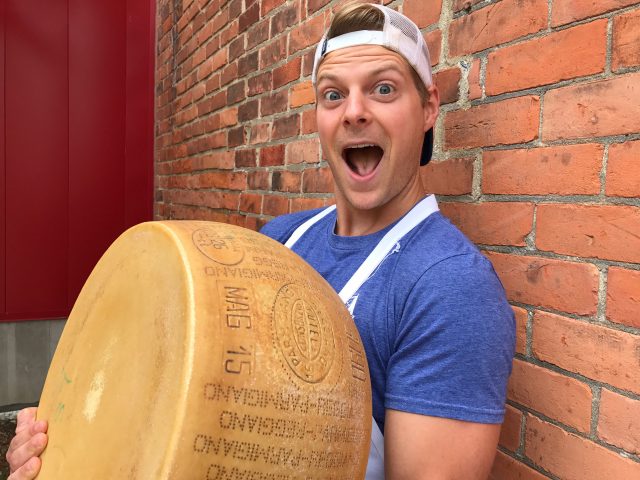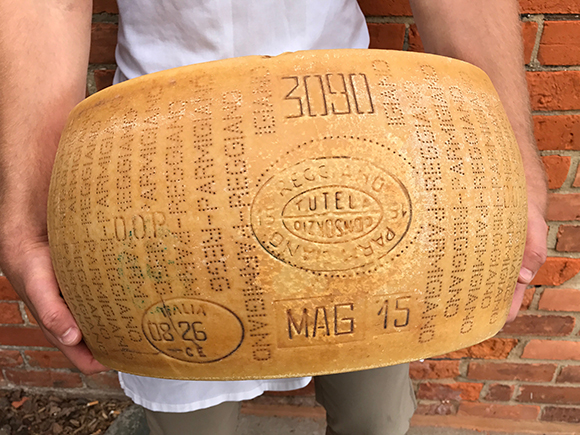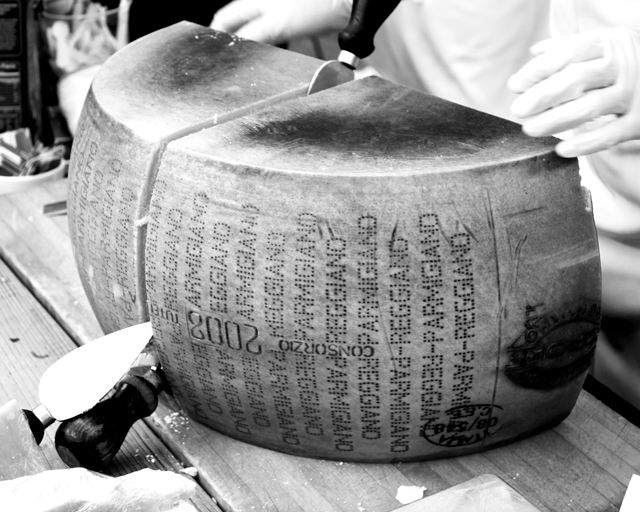 One of the key principles by which we’ve lived and worked since we opened in 1982 is our continual effort to improve in all we do! It’s a never-ending process that’s been happening over and over again for nearly 32 years now. In the last few years, we’ve undertaken a number of new projects here at Zingerman’s to take our food to new levels of excellence. But of all of that inspiring and meaningful work, our Parmigiano Reggiano® Project could be one of the most personally exciting things we’ve engaged in. In 2017, Ari noticed that the Parmigiano Reggiano at the Deli cheese counter was lacking in what we’d come to expect as exceptional. In his quest to elevate our selection of Parmigiano Reggiano to new heights, he and Grace Singleton, managing partner of Zingerman’s Deli, embarked on an adventure throughout Italy to source the best of the best. Read on for Ari’s top things to know about the King of Cheese.
One of the key principles by which we’ve lived and worked since we opened in 1982 is our continual effort to improve in all we do! It’s a never-ending process that’s been happening over and over again for nearly 32 years now. In the last few years, we’ve undertaken a number of new projects here at Zingerman’s to take our food to new levels of excellence. But of all of that inspiring and meaningful work, our Parmigiano Reggiano® Project could be one of the most personally exciting things we’ve engaged in. In 2017, Ari noticed that the Parmigiano Reggiano at the Deli cheese counter was lacking in what we’d come to expect as exceptional. In his quest to elevate our selection of Parmigiano Reggiano to new heights, he and Grace Singleton, managing partner of Zingerman’s Deli, embarked on an adventure throughout Italy to source the best of the best. Read on for Ari’s top things to know about the King of Cheese.
For me, it represents so much of what we try so hard to do—to take an already excellent offering to new levels of quality, share new “learnings” about “old” offerings, connect with artisan producers in ever more meaningful ways, and bring more flavorful food to our customers and crew.
A few years ago we introduced four new sources of superb Parmigiano Reggiano cheese from four different dairies, each with its own style and personality and each making marvelous, distinctive, and super high-quality cheese. Grace Singleton (one of the managing partners at the Deli) and I visited Italy twice and tasted through probably 100 samples of cheese before settling on these four. Check out zcob.me/parm for more on these fine dairies!
Our work, of course, is not done! This year, we’re working to bring even more variety—different ages,different seasons. Part of the educational work as we take this project to the next level is to continue to share more in-depth info about the intricacies and idiosyncrasies that make this amazing cheese so amazing. What follows, I suppose, could qualify as an advanced course—Parmigiano Reggiano 401. For those of you who are ready to take your knowledge and eating to the next level, here are a whole host of things you might not yet know about this marvelous cheese.
1. It’s a great eating cheese!
To my taste, Parmigiano Reggiano is the eating cheese. While I know that it is, of course, most famous for grating, cutting a chunk and eating it is what I like to do. This is about beliefs, I suppose. Because people believe the Parmigiano Reggiano is really just for grating, that’s what they keep doing. But, compare this Italian classic to cheddar. It’s also good for grating. But no one bills it as a grating cheese, right? While I know enough to know that I can’t make anyone change their beliefs, what I can do is give you evidence that an alternative belief might make your life (or at least your eating life) better. The bottom line? If you haven’t been regularly nibbling on freshly broken nuggets of Parmigiano Reggiano, I think you’re missing out big time! Next time you’re thinking of a cheese to put out on a cheese board, stick in your kid’s (or your own) lunchbox, or just to nibble on nicely while making dinner, make Parmigiano Reggiano your top pick. Once you start eating it, you’ll never, ever go back. The insightful (and now also famous) chef Massimo Bottura hails from Modena, an important district in the Parmigiano Reggiano producing region (Massimo calls it, “the land of fast cars and slow food”).
I ran into him at a Slow Food conference in Denver this past summer, and he shared, “I grew up eating this cheese. I used to hide under the table when my grandmother made tortellini. My bones are made of Parmigiano Reggiano!”
2. Grating on salad or soup is just as great as grating onto pasta
If you are going to grate, consider expanding your Parmigiano Reggiano horizons. I eat a lot of pasta, but there are so many foods upon which to sprinkle this cheese! It’s super good grated onto a green salad, and it couldn’t be easier. There’s something about the way that the Parmigiano Reggiano takes to lettuce leaves and absorbs the oil and vinegar and black pepper and . . . man. Delicious! It’s also super on soup! I particularly like it on vegetable or bean soups. The cheese slightly thickens the soup,and its terrific “meaty” umami nature rounds out the flavor! And then, of course, there are rice dishes— polenta, wheat berries, and porridge. One of my all-time favorite go-to meals is Martelli maccheroni or Rustichella fettuccine, cooked very al dente, drained, and then tossed with a plethora of freshly grated Parmigiano Reggiano, a healthy dose of just ground, really high-quality black pepper, and a great olive oil. Add a spoonful of fresh ricotta on top if you want to fancy it up! It’s a fabulous way to feel better after a stressful day—a world-class meal you can make in under 20 minutes.
3. One is Not Enough
A couple of questions to put this point in context: How many different wines have you enjoyed this year? How many brands of beer have you poured? How many different chocolates have you eaten? I’m guessing most people who are into any, or all, of those will have an answer that goes into many dozens. Even olive oil—many of our good customers will have two, three, four different oils on their counter at home to experience delicious, but different, flavors from different producers. Variety, you already know, is the spice of life. Diversity is a great thing, so why then settle for a single offering of Parmigiano Reggiano?
The biggest reason, I suppose, is supply—most local shops or upscale supermarkets have long sold only a single Parmigiano Reggiano offering. If you go to the same place to shop every week, then by definition, that’s what you’re going to eat. And while there’s nothing inherently wrong with that, the truth is that if we eat only the Parmigiano Reggiano from one producer, we’re most definitely missing out!
If you want to make a positive impression—even just on yourself—put out a cheese board with three or four different Parmigiano Reggiano cheeses. Maybe the 26-month old cheese from the Roncadella dairy in the lowlands that’s milky, marvelously mild, fresh and delicious. A big-boned, bolder, 24-month-old from the Borgotaro co-op in the mountains; a really sweet succulent, honey-like cheese from the Raverano co-op further to the south; and a four year, ultra-aged masterpiece made from the milk of brown cows at the Valserena dairy down in the plains. All will be excellent, all will amaze you, all will leave you wanting more! And the difference, diversity, and lovely variation between them, while all well ensconced in the frame of very fine Parmigiano Reggiano, will take your cheese-eating and appreciation experience to new and super-tasty heights! And since all four of the dairies I’ve mentioned—the ones we sourced after tasting more than 100 different cheese samples during two different week long trips to Italy last year—are excellent, you’re pretty much guaranteed to be smiling. For some, the hardest part will be picking a favorite. Thinking anarchistically and inclusively, I’ll simply eschew the entire issue. I can like each of them for what they are without trying to rank them in hierarchical order. I love them all equally, each for what they—and the man or woman who made them—are!
 My message? In the way that I’ll bet almost no one settles for a single wine day in and day out, the same is true with Parmigiano Reggiano. Mix and match, pair and partner, point and counterpoint. The whole point of Zingerman’s Parmigiano Reggiano Project is to help show the superb diversity of qualities and complexities that exist. Quality is a baseline for every cheese that bears the Parmigiano Reggiano “brand.” But within that high-quality construct, there’s a whole playing field full of Parmigiano Reggiano possibilities.
My message? In the way that I’ll bet almost no one settles for a single wine day in and day out, the same is true with Parmigiano Reggiano. Mix and match, pair and partner, point and counterpoint. The whole point of Zingerman’s Parmigiano Reggiano Project is to help show the superb diversity of qualities and complexities that exist. Quality is a baseline for every cheese that bears the Parmigiano Reggiano “brand.” But within that high-quality construct, there’s a whole playing field full of Parmigiano Reggiano possibilities.
4. Different flavors for different palates
For openers, each of us likes different things. Different Parmigiano Reggiano offerings for different palates. And since it is one of nearly every cheese lover’s favorites, it only makes sense to offer a range of options, just as we do olive oils, or as any good wine shop would have an array of Cabernets, etc. So, we set out to source a wide-ranging palette of Parmigiano Reggiano cheeses that can meet every situation and every set of taste buds. While it’s marketed with the formal quality stamp of approval of the Parmigiano-Reggiano Consorzio, the truth is that there are over 300 dairies making Parmigiano Reggiano. And each producer has their own quirks, their own styles, and make choices about aging techniques, temperatures, etc., all of which impact the cheese. Look at it like a “traditional” country song. You can find 50 versions, all basically the same song, but all sounding slightly different, all true to the musician who’s making it. The same is true for the cheese.
5. Different flavors for different situations
In the same way that we’ve learned over the years to pair different olive oils with different dishes (lighter oils like ROI from Liguria for lighter dishes like lemon sole, and bigger oils like Poggio Lamentano from Tuscany to pair with steaks, bean dishes, or fresh tuna, for example), the same thing is true with Parmigiano Reggiano!
Pick and choose your cheese to fit your needs. You can use a lighter softer, sweeter cheese like Valsarena after dinner, or a bigger flavored cheese like Borgotaro to put atop a pasta tossed with a meat ragu, or the wonderful buttery cheese from Roncadella atop a plate of traditional tortelloni. You might shave slices of a young Roncadella Parmigiano Reggiano on a lovely fall salad with apples, walnuts, and endive. Or put some of the organic cheese from La Villa out after dinner with a glass of Moscato wine.
There is, I’ve come to realize quite clearly, a Parmigiano Reggiano for every plate, a different cheese for every dish. This theory was confirmed repeatedly on last year’s visit to the region. Getting to go into some homes and cook with some of the locals demonstrated what I should have known all along–that they will always tailor the cheese they choose depending on the dish in which they’re using it. And that they always taste the cheese before making a final call on when, where and how much to use!
6. Every season’s cheese is different
The truth is that really every day’s cheese–even from the same dairy–will be slightly different. This is normal and appropriate. In the way that, say, the buttermilk biscuits at the Roadhouse are always really good (we bake and sell thousands each week), each will be slightly different, and the same is true for the cheese.
For the history buffs amongst you, it’s worth knowing that up until 1984, official Parmigiano Reggiano could only be made during spring, summer, and fall—April 15 through November 15. But improvements in the consistency of feeding helped minimize issues with winter cheese, so now we have access to all four seasons’ worth of very fine cheese.
7. Every breed’s milk is a bit different
Different breeds are to cheesemaking what different grapes are to winemaking. Same basic genre but different flavor nuances in the “juice.” Most of the cows in the region today are black and white, modern Holstein Friesians. But there are still some of the more traditional breeds to be found—some of the very old “white cows” (protected on the Slow Food Ark) and “red cows.” Hopefully, in the coming years, there will be more and more of these old breeds being milked in the region. The biggest push over the years has been with the wonderful Brown Swiss. Happily for us, one of our four chosen dairies—Valserena—has a herd of only Brown Swiss. It’s one of the oldest dairy breeds, dating back about six thousand years to the Swiss Alps. The flavor and fat of the milk are considered excellent, and so, too, is the quality of the Valserena’s fine cheese!
8. Make sure it’s at room temperature
This is true, of course, with all great cheese, cured meat, and really almost any great food that’s not supposed to be served really cold or really hot. It’s simple—if you serve the cheese right out of the refrigerator, at say 30-40ºF, you will miss out on the complexity of flavor that’s in the cheese. And after you’ve gone to so much trouble to get such terrific cheese, why leave the actual excellence of the flavor out of your eating equation? It’s like going to Hawaii and then spending the day inside your hotel room watching TV! So be sure to get the cheese to room temp before you serve.

9. It’s incredible with honey
There are so many great pairings in the world of food—peanut butter and jelly, corned beef and rye, hot dogs with mustard, bagels and cream cheese, the list is long. While it gets far less fame than any of those I just listed, this Parmigiano Reggiano and honey pairing is as powerfully good as all the others. If you like good cheese and you like good food, you like a bit of sweet with your savory (or maybe it’s a bit of savory with your sweet), you’re pretty much guaranteed to love this combo! Parmigiano Reggiano and a great varietal honey is delicious! I kind of go crazy every time I eat it! Varietal honey, of course, refers to old-school honeys that come from single flower sources—where the bees are buzzing around the blossoms of a particular variety of flower, or in some cases, fields of fabulous wild flowers. We have more than 25 varietal honeys to pick from at Zingerman’s—you can pair them up and try different pieces of Parmigiano Reggiano with different honey to find your favorites.
Some of my faves? I love the Chestnut honey from Tuscany, the Cardoon from Sardinia, Mountain Honey from the Piedmont…but really, they’re all fantastic. I don’t think you can go wrong with any pairing you can come up with! Kids, by the way, almost always love this combination! Great way to get them aware of the intricacies of great food in a healthy, natural, nutritious, and very happy way! Entertaining? Put out a board of three or four different offerings of Parmigiano Reggiano, and three or four different honeys. Your guests will be oohing and aahing all night.
10. Wonderful with sparkling wine
Sande Friedman, who works with our friends the Di Bruno Brothers in Philly, wrote that, “With big, crunchy cheeses and sparkling wine, take a bit of caution in making sure not to create too intense of a pairing. That said, bubbly wine is an excellent thing to have all of the time, so figure out fun ways to make this work. Parmigiano Reggiano has such an old-school Italian personality that it would be crazy not to go for Italian sparkling wine to pair. You’ve got two great options here: Prosecco and Lambrusco. On the bubbly side, a not-too-dry sparkling wine can balance the salt, refresh the palate and bring out the underlying richness of the milk. Lambrusco is the wine of the Parmigiano Reggiano region, and it combines the best qualities of both red and sparkling wine. All of these suggestions work with Parmigiano Reggiano on its own, or in dishes like pasta or risotto, where it’s the dominant ingredient. ”There’s just something amazing about this pairing that makes me want to put them together! Serve some of each at your next get together—or treat yourself when you’re dining alone—a small bit of each will always improve the excellence of your evening!
11. Always break, don’t cut
Perhaps most important of all—the best way by far to enjoy Parmigiano Reggiano is to break it into small, rough-texture pieces. The eating experience is significantly more interesting because you get more cheese exposed to your tongue. The uneven surface allows you to experience the cheese’s full complexity. By contrast, our “normal” American routine of slicing cheese with a knife leaves a surface that looks smooth but makes for suboptimal eating! One never wants to see straight-sided cubes of Parmigiano Reggiano. Instead, you’ll want to use the small, almond-shaped knives made especially for this purpose. When it’s done right, you end up with rough-edged “nuggets” of cheese.
12. Enjoy those crystals
One of the magical things about biting into a piece of really well-aged Parmigiano Reggiano is the feel of those tiny sharp crystals crunching on your tongue. Many folks mistakenly take these to be salt crystals, but they aren’t. During the aging process, the proteins in the cheese are broken down into smaller nutritional units (peptones, peptides, and free amino acids, in case you were wondering). Some of these—particularly tyrosine—are naturally converted into a crystalline structure. Their presence is one of the signs of a well-made cheese and long aging.
13. Great for travel
For long plane trips, I almost always take two things—good bread and a reasonably-sized chunk of cheese (not too big, but not so small that it’s gone after we’ve barely just begun the trip). Both hold up well in all temperatures. Both will pass through pretty much every customs and security agent. Both are delicious. Both last without refrigeration. Both taste terrific. I can eat them for a meal if I get stuck somewhere.
14. The fresher cut, the better
While it’s true that Parmigiano Reggiano is made to last, it’s also true that the sooner you eat the cheese after it’s been cut from the large, 80-pound or so wheel, the better it’s going to be! Try not to buy too far ahead. Now mind you, I’m not trying to reduce your purchase size. But the truth is that you’re going to be eating better cheese if you come by every couple of days and get some more. This is also true, by the way, for grating. I always grate my cheese either directly into or onto the dish I’m making. Or for a recipe that requires fast integration of ingredients, then I might, at most, grate the cheese ten minutes before I’m going to use it.




